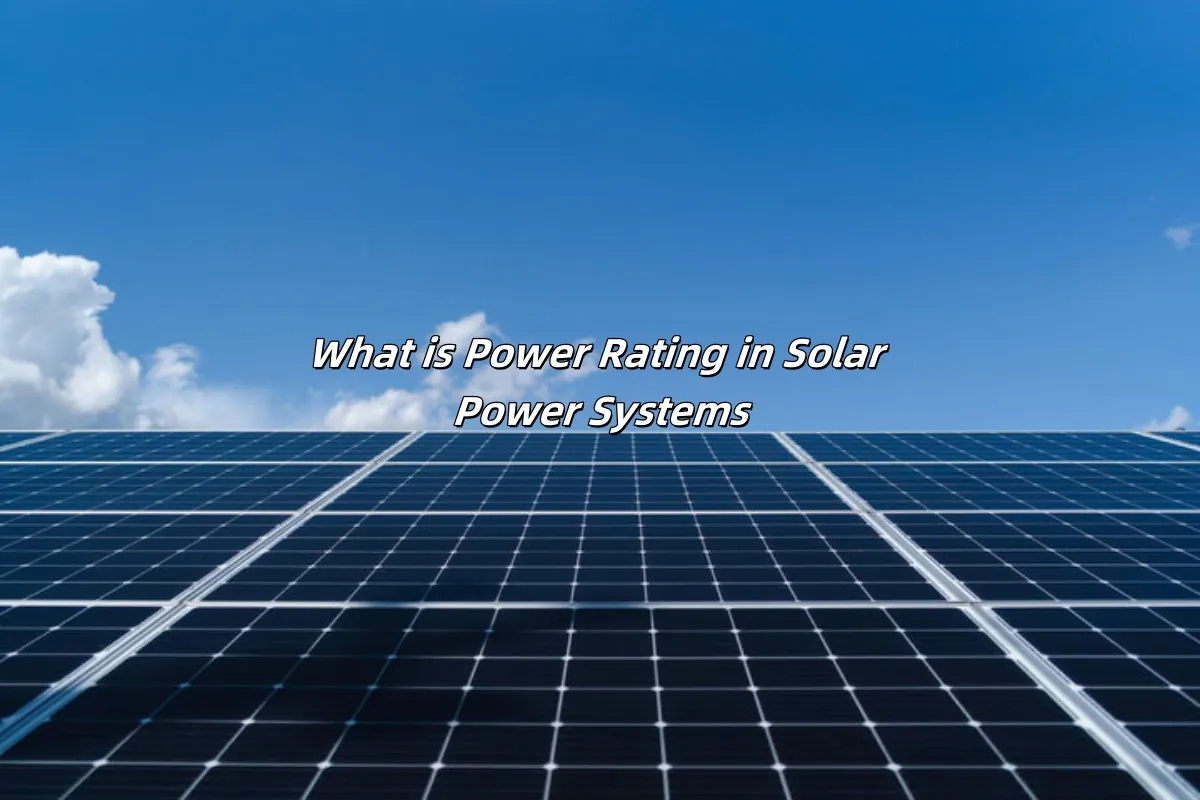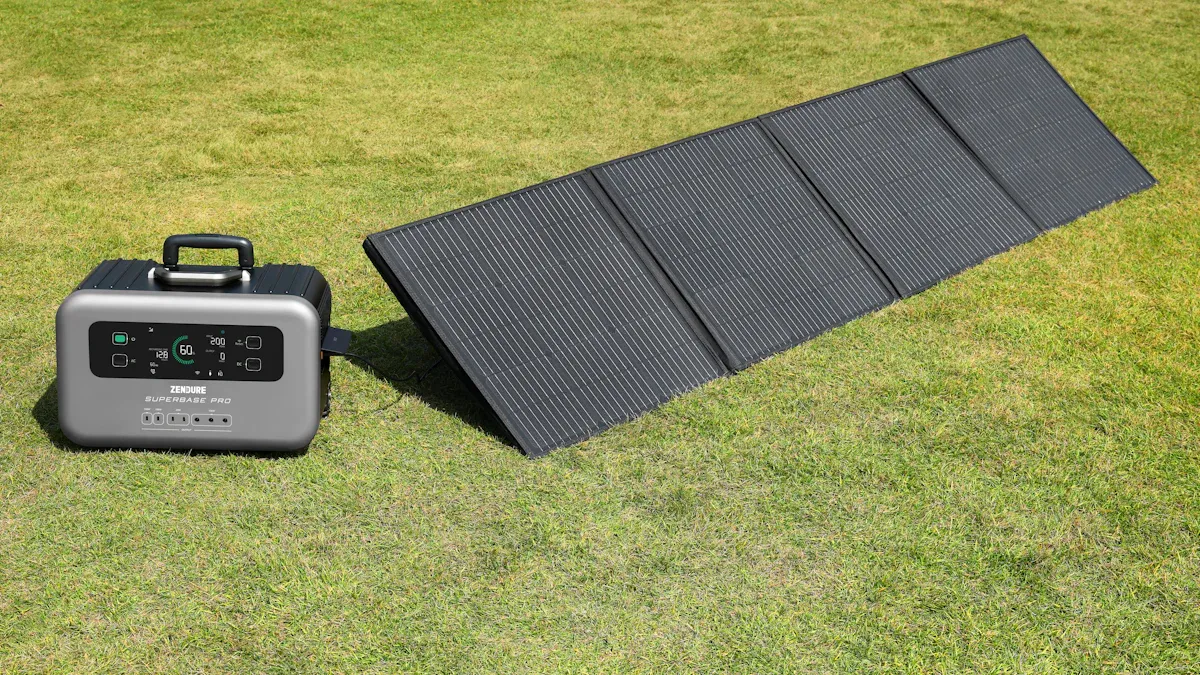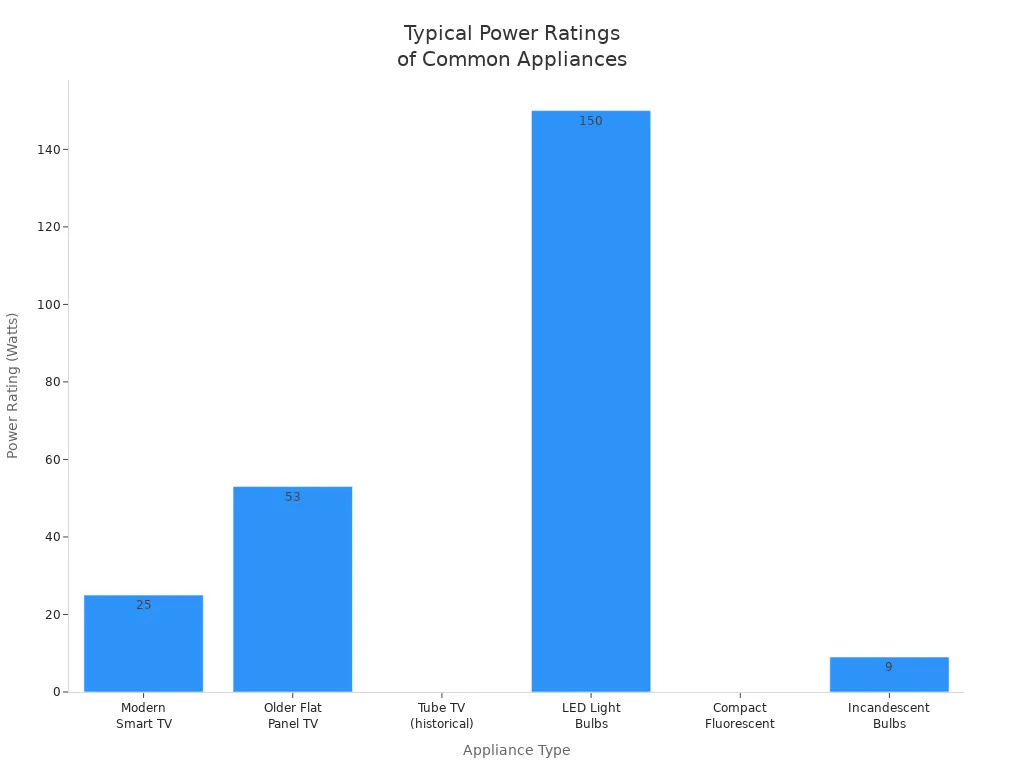+86 17727759177
inbox@terli.net
- All
- Product Name
- Product Keyword
- Product Model
- Product Summary
- Product Description
- Multi Field Search
Views: 0 Author: Site Editor Publish Time: 2025-07-31 Origin: Site
Power rating shows the most power a solar device can use or make safely. If you know about power rating, you can pick the right tools and stop your system from getting too much power. Some people think solar panels do not work well, but new panels give enough energy for most houses. New research says that using high-efficiency panels with bigger power ratings can help you save money. You get more energy from the same roof area, and your system works better for a longer time.

Power rating tells you the most power a solar device can make or use. This helps you pick the right equipment. It also keeps your system safe.
Solar panel power ratings are measured in watts in perfect labs. But real-life power is usually less. This is because of weather and the environment.
Always look at the power rating labels on your solar panels, generators, and appliances. This helps you match your system size. It also stops overloads or damage.
Use power ratings to plan your solar system size. Add up the power your appliances need. Think about sunlight hours and system losses too.
Keep your solar panels clean and out of shade. This helps you get the best power. Check your system often to keep it safe and working well.
It is important to know what power rating means before picking solar equipment. Power rating is the most power a device can safely use or make. In solar power systems, power rating shows how much electricity a panel can give when everything is perfect. When you see a solar panel’s power rating in watts, it tells you the power you get with bright sun and good weather.
Power rating for solar panels is the power you expect in perfect sunlight, measured in watts.
You find this by multiplying voltage and current: Volts times Amps equals Watts.
Voltage is the electrical force the panel gives at its best.
Current (amps) is how many electrons move through the panel.
Wattage is the energy made when electrons move and meet resistance.
The wattage rating tells you the power the panel can make in one hour of perfect sun.
If the wattage rating is higher, the panel can make more electricity in the same space.
Solar panel power ratings are set by global rules. Agencies use rating systems like STC-DC and CEC-AC. The STC-DC rating checks power in a lab with perfect sunlight and temperature. The CEC-AC rating looks at real-world power, including losses from the inverter and other parts. These rules help you compare panels and know what your system can do.
You will see different units when looking at power ratings. The most common unit is the watt (W). Bigger systems use kilowatts (kW), megawatts (MW), or gigawatts (GW). These units show how much power a device can use or make at one time.
| Unit | Definition | Conversion Relationship |
|---|---|---|
| Watt (W) | Unit of power showing how fast energy is used or made | Base unit of power |
| Kilowatt (kW) | 1000 Watts | 1 kW = 1000 W |
| Megawatt (MW) | 1000 Kilowatts | 1 MW = 1000 kW |
| Gigawatt (GW) | 1000 Megawatts | 1 GW = 1000 MW |
For example, a solar panel with a power rating of 345 watts can make up to 345 watts of electricity in perfect sunlight. If you use a 100-watt light bulb for one hour, it uses 100 watt-hours or 0.1 kilowatt-hours (kWh) of energy. Power shows how much energy you use at once. Energy (like kWh) shows how much you use over time.
When you buy solar equipment, you will see power ratings on the labels. These labels follow strict rules to keep you safe and help you compare products. International rules like UL 1703, IEC 61215, and IEC 61646 make sure labels show the right information for different solar panels. In the United States, the National Electrical Code (NEC) Article 690 says labels must list important details like:
Polarity (positive or negative)
Maximum fuse or circuit breaker rating
Open circuit voltage (Voc)
Operating voltage (Vpmax)
Maximum system voltage allowed
Operating current (Ipmax)
Short circuit current (Isc)
Maximum power (Pmax)
Tip: Always look at the label for the rated power and other details before you install or use solar equipment. This helps you pick the right parts and stay safe.
Manufacturers test each solar panel and sort them by how well they work. Even panels that look the same can have different power ratings because of small differences inside. Labels use strong materials so you can read them for many years, even in bad weather. Government rules make sure labels are correct and easy to read. Programs like ENERGY STAR help you find products that use less energy and save money.
You should always check the power rating when using a solar generator. If you do not, your equipment could break or even catch fire. Each solar generator and its parts can only handle a certain amount of power. If you plug in things that need more power than allowed, wires and inverters can get too hot. Too much heat can damage the insulation and cause danger. Certified installers use good parts and follow rules to keep your solar generator safe. They make sure all wires and inverters stay within their power ratings. Checking your system often helps you find problems early. Doing these things keeps your solar generator safe and working for a long time.
Note: Never use a solar generator or any device with more power than its power rating. This rule keeps your home and your money safe.
The power rating tells you how much electricity your solar generator can make in perfect conditions. This number helps you know how much energy you might get. If you match the power rating with the right inverter and other parts, your system works best. When you look at the real output and compare it to the power rating, you can see if your solar generator is working right. If you see it is not making as much power, you can fix it before it gets worse. The power rating also helps you watch how your solar generator works over time. This helps you keep your system running well and not waste energy.
Power ratings help you figure out how many solar generators you need at home. For example, if you want a 6.5 kW system, you can use twenty solar generators with a 325 watt rating each. If the power rating is higher, you need fewer solar generators to get the energy you want. This saves roof space and can cost less money. When you plan your system, you look at how much energy you use each month and divide it by the average output of each solar generator. You also think about your roof size, which way it faces, and how much sun you get. Over time, solar generators lose some efficiency, so you might add a little extra power. Using power ratings helps you make sure your system is the right size and works well for many years.

Image Source: unsplash
Solar panels have their rated power listed in watts. This number shows the most electricity a panel can make when conditions are perfect. Manufacturers test panels in labs using Standard Test Conditions (STC). These tests use sunlight at 1000 watts per square meter. The cell temperature is set at 25°C. The air mass is 1.5 at sea level. These lab settings help you compare different solar panels because every panel is tested the same way.
Note: The rated power on the label comes from these lab tests. Real sunlight and weather are not always perfect, so your solar panels may not reach their full rated power outside.
In real life, solar panels usually make less power than their rated power. Things like clouds, dust, shade, and heat can lower the output. Manufacturers also give you a Nominal Operating Cell Temperature (NOCT) rating. This rating uses more common outdoor conditions. It uses 800 W/m² sunlight, 20°C air temperature, and a light breeze. Under NOCT, solar panels usually make about 70-80% of their rated power. For example, a 400-watt panel might give you around 300 watts on a sunny day outside.
You should use the rated power as a guide, but remember your actual output will change with the weather and your location. This helps you plan your solar generator system better and avoid surprises.
A solar generator uses the rated power to show how much electricity it can give you all the time. This number is called continuous power. It tells you the load your solar generator can handle without getting too hot or breaking down. Some devices need extra power to start, like refrigerators or pumps. For these, the solar generator also lists a peak power rating. Peak power is the most electricity the generator can give for a very short time, usually just a few seconds.
Continuous power: The amount your solar generator can supply all day without problems.
Peak power: The highest amount your solar generator can give for a short burst, like when starting a motor.
For example, if your solar generator has a rated power of 1000 watts and a peak power of 2000 watts, you can run devices up to 1000 watts all the time. If you plug in a device that needs 1800 watts just to start, your solar generator can handle it for a few seconds, but not for long. Always check both the rated power and peak power before you connect big appliances. This keeps your system safe and helps you avoid overloads.
Tip: Use the rated power to pick the right solar generator for your needs. Make sure the continuous power matches your daily use, and the peak power covers any short surges from your appliances.
Every appliance in your home has a power rating. This number tells you how much electricity it uses when running. You can find the rated power on the label, usually in watts or amps. If you see amps, you can multiply by the voltage (often 120 volts) to get watts. To plan your solar generator system, you need to add up the rated power of all the appliances you want to use at the same time.
Here is how you can check the rated power for your appliances:
Look for the power rating on the label. It is often on the back or bottom.
If the label shows amps, multiply by the voltage to get watts.
Multiply the wattage by the hours you use the appliance each day to find daily energy use.
If you cannot find the label, use a smart plug or energy monitor to measure real use.
You will notice that different appliances have very different power ratings. Some use very little, while others use a lot. For example, a modern smart TV uses about 25 watts, but an old tube TV can use up to 200 watts. LED bulbs use about 9 watts, while old incandescent bulbs use 60 watts. Air conditioners and heaters use much more.
| Appliance Type | Typical Power Rating (Watts) | Notes |
|---|---|---|
| Modern Smart TV | ~25 | Example: 24 inch smart TV for RV, much lower than older models |
| Older Flat Panel TV | 38 - 68 | Example: 2018 and 2008 models with higher consumption |
| Tube TV (historical) | 100 - 200 | Outdated values, no longer representative |
| LED Light Bulbs | ~9 | Replacement for 60W incandescent bulbs |
| Compact Fluorescent | ~13 | Replacement for 60W incandescent bulbs |
| Incandescent Bulbs | 60 | Traditional incandescent bulb power draw |
| 8,000 BTU Window AC | Significant kWh consumption over days | Example given with 26+ kWh over 10 days, varies with usage |

When you design your solar generator system, you need to add up the rated power of all the appliances you want to run at the same time. This helps you choose a solar generator with enough rated power and peak power. If you use many appliances at once, you need a bigger solar generator. If you use fewer, you can pick a smaller one and save money.
Reminder: Your daily energy use changes with the season and your habits. In summer or winter, you may use more power for cooling or heating. Always check your power ratings and plan for the highest use days.
You can plan your solar system by first figuring out your daily energy consumption. Add up the watt-hours for every device you want to use. Next, check how many hours of good sunlight you get each day. This number changes with your location and the season. For example, in winter, you might only get two hours of strong sun. You can find sunlight data on websites like gaisma.com.
Here is a simple way to estimate your needs:
Multiply the wattage of each solar panel by the number of usable sunlight hours. For example, a 300-watt panel × 4 hours = 1,200 watt-hours.
Divide your daily energy consumption by the daily output of one panel. For example, if you use 30 kWh per day and each panel gives 1.2 kWh, you need 25 panels.
Adjust for system losses by multiplying your total by about 1.4. This helps cover real-world losses.
Always match your system size to your highest expected energy use. This keeps your solar generator running smoothly.
The power rating on a solar panel shows its best possible output in perfect lab conditions. Real life is different. You will usually get less power than the label says. Most people see only 60% to 80% of the rated power. High temperatures, system losses, and battery limits can lower output even more. For example, if your panel gets too hot, it can lose about 20% of its power. Even on a cool, sunny day, you may only reach about 92% of the rated power.
Panels with higher efficiency ratings make more electricity from the same amount of sunlight. This means you need fewer panels for the same energy consumption. Always check both the power rating and efficiency when you choose panels.
Many things in your environment can change how much power your system makes. High temperatures lower the efficiency of your panels. Dust, smog, and shade from trees or buildings can block sunlight and cut your output. Snow or dirt on the panels also reduces power. The angle of the sun changes during the day and year, which affects how much sunlight your panels get. Extreme weather, like storms or wildfires, can cause sudden drops in power.
To get the most from your system:
Clean your panels often.
Trim trees or move objects that cause shade.
Use smart inverters and monitoring tools to track performance.
Plan for the worst days, not just the best.
Good energy management means you look at both the power rating and your local conditions. This helps you avoid overloads and keeps your system working well.
Knowing how solar systems work helps you make smart choices. You can keep your system safe and save money. If you learn about system sizing and panel direction, you avoid mistakes. Using good parts also helps your system last longer.
A good design and regular checkups keep your system working.
Things like heat and sunlight change how well your system works.
Helpful websites like Energy.gov and NREL have guides and tools.
Always look at your system details and plan for what you really need. This helps your system work well for many years.
"Watts peak" (Wp) shows the most power your solar panel can make in perfect sunlight. You use this number to compare panels. Real output may be lower because of weather or shade.
Yes, you can. A higher-rated panel gives you more power. Your device will only use what it needs. This setup can help you charge faster or run more devices.
Look for a label on your appliance. You will see the power rating in watts or amps. If you see amps, multiply by the voltage to get watts. You can also check the user manual.
Many things affect output. Clouds, dust, heat, and shade lower the power your system makes. The rated power comes from lab tests. Real-life conditions are not always perfect.